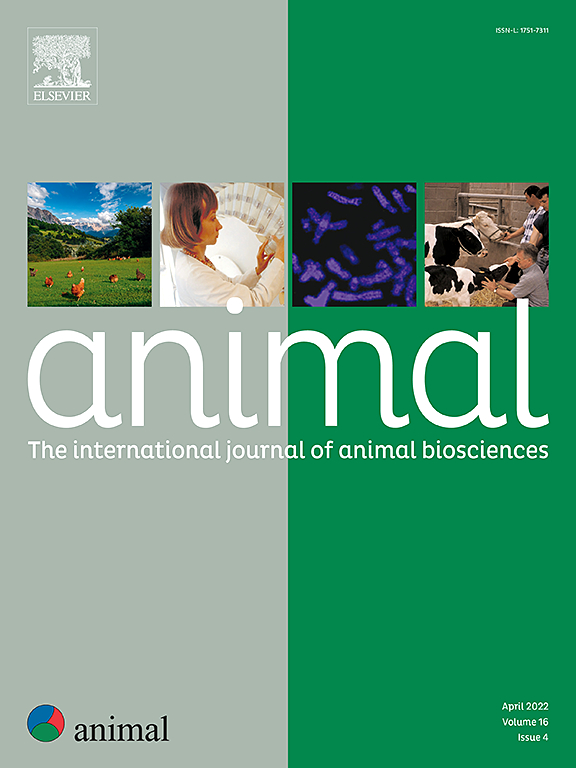Genetic parameters for milk production traits of Simmental cows with random regression test-day model
IF 4
2区 农林科学
Q1 AGRICULTURE, DAIRY & ANIMAL SCIENCE
引用次数: 0
Abstract
Precise genetic parameter estimates can allow the breeding value evaluation to be adjusted to meet European requirements and to enable participation in the international evaluation of Simmental bulls conducted by Interbull. Genetic parameters were estimated for a multitrait multilactation random regression test-day model for milk in Simmental cattle in Poland. Data came from the official Polish national recording system. Records of 6 447 Simmental cows born from 2002 through 2021 in 1 046 herds were collected. The cows were daughters of 987 sires and 4 590 dams. A minimum of two daughters per sire was required. Daily yields were collected between 5 and 305 days in milk. The BLUPf90 package and a Bayesian method via Gibbs sampling were used to estimate (co)variance components. The model contained fixed herd-test-date effect, fixed regressions within age-season of calving classes, and random additive genetic and permanent environmental regressions. The Wilmink function was used for fixed regressions, and third-order Legendre polynomials for random regressions. The mean heritability for daily milk yields and milk composition ranged from 0.12 (somatic cell score) to 0.41 (protein content in milk). The majority of the analysed traits were most heritable at the end of 305-d lactation. Genetic correlations between daily milk, fat, protein and lactose yields were positive and high (0.78–0.99). This meant that selection for one of those milk traits indirectly induced a similar response in another milk trait. The lactational heritabilities of all nine traits were much higher than the estimates of average daily heritabilities, and varied from 0.29 for somatic cell score to 0.74 for urea content in milk. For both daily and lactational parameters, traits expressed in percent were more highly heritable than yield traits. The values of the genetic parameters estimated in this paper can be used when a single-trait multilactation random regression test-day animal model for production traits is applied in the official genetic evaluation of the Simmental population, replacing the current lactation model.
用随机回归试验日模型研究西门塔尔奶牛产奶性状的遗传参数。
精确的遗传参数估计可以使育种价值评估进行调整,以满足欧洲的要求,并能够参与Interbull对西门塔尔公牛进行的国际评估。对波兰西门塔尔牛多性状多泌乳随机回归试验日模型的遗传参数进行了估计。数据来自波兰官方国家记录系统。收集了2002年至2021年在1046个畜群中出生的6447头西门塔尔奶牛的记录。这些牛是987头公牛和4590头公牛的女儿。每一位父亲至少需要两个女儿。日产奶量在5至305天之间。BLUPf90包和贝叶斯方法通过吉布斯抽样估计(co)方差成分。该模型包含固定的群体-测试-日期效应、固定的产犊类别年龄-季节回归以及随机的加性遗传和永久性环境回归。固定回归采用Wilmink函数,随机回归采用三阶Legendre多项式。日产奶量和乳成分的平均遗传率为0.12(体细胞评分)~ 0.41(乳中蛋白质含量)。在哺乳期305 d结束时,大多数性状的遗传性最好。日产奶量、脂肪产奶量、蛋白质产奶量和乳糖产奶量呈高正相关(0.78 ~ 0.99)。这意味着对其中一种牛奶性状的选择间接地引起了另一种牛奶性状的类似反应。9个性状的哺乳期遗传力均远高于平均日遗传力的估计值,从体细胞评分的0.29到乳中尿素含量的0.74不等。在日育和泌乳参数上,以百分数表示的性状比产量性状具有更高的可遗传性。本文估计的遗传参数值可用于西门塔尔种群的官方遗传评价中,用于生产性状的单性状多泌乳随机回归试验日动物模型,取代目前的泌乳模型。
本文章由计算机程序翻译,如有差异,请以英文原文为准。
求助全文
约1分钟内获得全文
求助全文
来源期刊

Animal
农林科学-奶制品与动物科学
CiteScore
7.50
自引率
2.80%
发文量
246
审稿时长
3 months
期刊介绍:
Editorial board
animal attracts the best research in animal biology and animal systems from across the spectrum of the agricultural, biomedical, and environmental sciences. It is the central element in an exciting collaboration between the British Society of Animal Science (BSAS), Institut National de la Recherche Agronomique (INRA) and the European Federation of Animal Science (EAAP) and represents a merging of three scientific journals: Animal Science; Animal Research; Reproduction, Nutrition, Development. animal publishes original cutting-edge research, ''hot'' topics and horizon-scanning reviews on animal-related aspects of the life sciences at the molecular, cellular, organ, whole animal and production system levels. The main subject areas include: breeding and genetics; nutrition; physiology and functional biology of systems; behaviour, health and welfare; farming systems, environmental impact and climate change; product quality, human health and well-being. Animal models and papers dealing with the integration of research between these topics and their impact on the environment and people are particularly welcome.
 求助内容:
求助内容: 应助结果提醒方式:
应助结果提醒方式:


